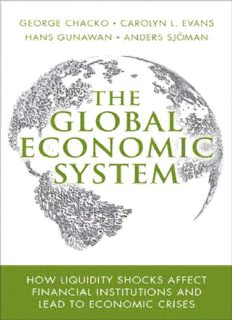
The Global Economic System: How Liquidity Shocks Affect Financial Institutions and Lead to Economic Crises PDF
Preview The Global Economic System: How Liquidity Shocks Affect Financial Institutions and Lead to Economic Crises
The Global Economic System How Liquidity Shocks Affect Financial Institutions and Lead to Economic Crises George Chacko Carolyn L. Evans Hans Gunawan Anders L. Sjöman Vice President, Publisher: Tim Moore Associate Publisher and Director of Marketing: Amy Neidlinger Executive Editor: Jim Boyd Editorial Assistant: Pamela Boland Senior Marketing Manager: Julie Phifer Assistant Marketing Manager: Megan Colvin Cover Designer: Alan Clements Managing Editor: Kristy Hart Project Editor: Betsy Harris Copy Editor: Geneil Breeze Proofreader: Williams Woods Publishing Indexer: Lisa Stumpf Senior Compositor: Gloria Schurick Manufacturing Buyer: Dan Uhrig © 2011 by Pearson Education, Inc. Publishing as FT Press Upper Saddle River, New Jersey 07458 This book is sold with the understanding that neither the author nor the publisher is engaged in rendering legal, accounting, or other professional services or advice by publishing this book. Each individual situation is unique. Thus, if legal or financial advice or other expert assistance is required in a specific situation, the services of a competent professional should be sought to ensure that the situation has been evaluated carefully and appropriately. The author and the publisher disclaim any liability, loss, or risk resulting directly or indirectly, from the use or application of any of the contents of this book. FT Press offers excellent discounts on this book when ordered in quantity for bulk purchases or special sales. For more information, please contact U.S. Corporate and Government Sales, 1-800-382-3419, [email protected]. For sales outside the U.S., please contact International Sales at [email protected]. Company and product names mentioned herein are the trademarks or registered trademarks of their respective owners. All rights reserved. No part of this book may be reproduced, in any form or by any means, without permission in writing from the publisher. Printed in the United States of America First Printing June 2011 First Printing June 2011 ISBN-10: 0-13-705012-7 ISBN-13: 978-0-13-705012-3 Pearson Education LTD. Pearson Education Australia PTY, Limited. Pearson Education Singapore, Pte. Ltd. Pearson Education North Asia, Ltd. Pearson Education Canada, Ltd. Pearson Educación de Mexico, S.A. de C.V. Pearson Education—Japan Pearson Education Malaysia, Pte. Ltd. Library of Congress Cataloging-in-Publication Data The global economic system : how liquidity shocks affect financial institutions and lead to economic crises / George Chacko ... [et al.]. p. cm. ISBN 978-0-13-705012-3 (hbk. : alk. paper) 1. International finance. 2. Liquidity (Economics) 3. Financial crises. I. Chacko, George. HG3881.G57534 2011 332'.042—dc22 2011010482 George dedicates this to Hemu, Manju, Leah, and Shreya. Carolyn thanks her father and mother for all their support. Hans dedicates this book to his loving parents. Anders is, as always, in constant awe of Alvar. Contents 1. Motivation for Understanding Liquidity Risk 1.1. Peso Problem 1.2. Liquidity Risk—The Peso Problem of Our Time 1.3. WorldCom 1.4. Hedge Fund Returns 1.5. The Structure of This Book Endnotes 2. Liquidity Risk: Concepts 2.1. Introduction 2.2. What Is Liquidity? 2.3. Model of Liquidity Costs 2.4. Liquidity Risk and Liquidity Shocks 2.5. Liquidity Risk Premium 2.6. Why Bear Liquidity Risk? 2.7. Liquidity-Driven Investing (LqDI) 2.8. Liquidity Risk Exposure in Bank Balance Sheets 2.9. Propagation of Liquidity Shocks: Systemic Risk 2.10. From Liquidity Crisis to Credit Crisis Endnotes 3. The Great Depression 3.1. The Stages of a Liquidity Shock 3.2. Recognizing a Liquidity Shock—Interpreting the Data 3.3. Setting the Stage for the Trigger—the Background for the Great Depression 3.4. Stage 1: The Trigger 3.5. Stage 2: Change in Liquidity Demanded Throughout the Economy 3.6. Stage 3: Changes in Bank Balance Sheets 3.7. Stage 4: Banks Change Activities to Bolster Balance Sheets 3.8. Stage 5: Effect on Liquidity and Availability of Credit Throughout the Economy 3.9. Stage 6: Real Effects of Decline in Liquidity Observed Throughout the Economy 3.10. Conclusion: The Great Depression, a True Liquidity Shock Endnotes References 4. Japan’s Lost Decade 4.1. The Stages of a Liquidity Shock—Revisited and Expanded 4.2. Recognizing a Liquidity Shock—Interpreting the Data 4.3. Setting the Stage for the Trigger—the Background to Japan’s Lost Decade 4.4. Stage 1: The Trigger 4.5. Stage 2: Change in Liquidity Demanded Throughout the Economy 4.6. Stage 3: Changes in Bank Balance Sheets 4.7. Stage 4: Banks Change Activities to Bolster Balance Sheets 4.8. Stage 5: Effect on Liquidity and Availability of Credit Throughout the Economy 4.9. Stage 6: Real Effects of Decline in Liquidity Observed Throughout the Economy 4.10. Conclusion: Japan’s Lost Decade, a Liquidity Shock That Dragged On Endnotes References 5. The Great Recession 5.1. The Stages of a Liquidity Shock—Same Applies Now as with the Great Depression 5.2. Recognizing a Liquidity Shock—Interpreting the Data 5.3. Setting the Stage for the Trigger—the Background to the Great Recession 5.4. Stage 1: The Trigger 5.5. Stage 2: Change in Liquidity Demanded Throughout the Economy 5.6. Stage 3: Changes in Bank Balance Sheets 5.7. Stage 4: Banks Change Activities to Bolster Balance Sheets 5.8. Stage 5: Effect on Liquidity and Availability of Credit Throughout the Economy 5.9. Stage 6: Real Effects of Decline in Liquidity Observed Throughout the Economy 5.10. Conclusion Endnotes References 6. Conclusion 6.1. A Liquidity Crisis 6.2. Bank Accounting Changes 6.3. Bank Nationalization 6.4. Debt Guarantees 6.5. Central Bank Lending 6.6. Monetary Policy 6.7. Fiscal Spending 6.8. Preventing Liquidity Crises Endnotes Index
Description: